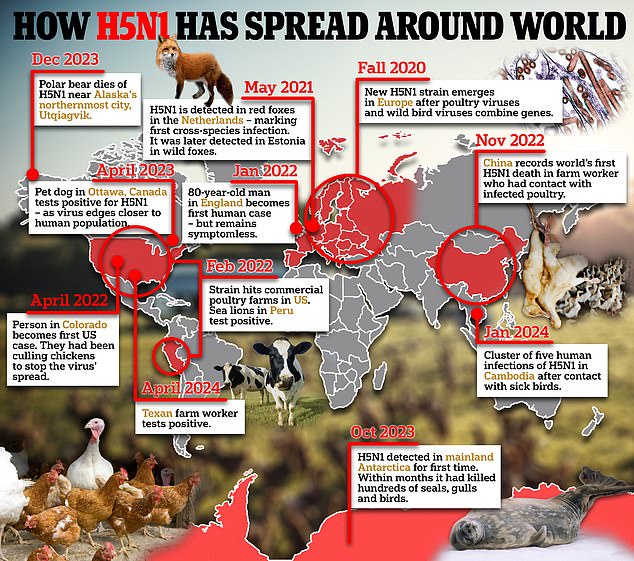- USDA to test whether cooking meat well-done will kill bird flu particles
- So far it has not been detected in meat, although it has permeated dairy cow herds.
- READ MORE: Traces of bird flu found in supermarket milk
U.S. health officials will begin testing ground beef for bird flu amid concerns that the virus could enter the commercial meat supply.
Federal health officials have insisted the meat is safe, but there are growing fears about the virus that has been detected in commercial milk after sweeping through farms across the country.
Three studies conducted by the Department of Agriculture (USDA) will analyze the presence of bird flu particles in beef sold in grocery stores or in the muscles of dairy cows sent to slaughter.
The research will also look for evidence that cooking meat thoroughly (opt for a well-done burger) will kill the virus.
A former FDA food safety expert previously urged DailyMail.com readers to eat only well-cooked beef and avoid runny eggs as the outbreak spreads.
Ground beef will be tested for bird flu. If detected, beloved American burgers may not be available for Memorial Day

To date, no bird flu has been found in cattle. But before last month, it had never been observed in dairy cows either.
In fact, tests on supermarket milk suggested that one in five products contains the virus, although experts insist the fragments are inactive and cannot infect people who drink the contaminated milk.
A USDA official said in a statement: “The USDA has a rigorous meat inspection process, where USDA Food Safety and Inspection Service (FSIS) veterinarians are present at all federal livestock slaughter facilities.”
The virus is only active when dairy is unpasteurized, a process that kills harmful bacteria and viruses. The department said the same goes for cooked meat.
However, some doctors urge more caution.
Dr. Darin Detwiler, a former food safety adviser to the FDA and USDA, recently told DailyMail.com that Americans should avoid raw meat and liquid eggs while the outbreak in livestock was ongoing, as the products Undercooked animals are more likely to carry viruses and bacteria.
Avian influenza A (H5N1) first emerged in 1996, but since 2020, the number of outbreaks in birds has grown exponentially, along with an increase in the number of infected mammals.
The strain has caused the death of at least 90 million wild birds and has also infected land and marine mammals. The virus was also found in goats, which were previously believed not to be susceptible.

Government health officials insist that traces of bird flu in milk are inactive and that the findings do not indicate that milk on grocery store shelves is unsafe.
There has also been a case in a Texas farmer, the first human affected in the US.
Dr. Barb Petersen, a dairy veterinarian in Amarillo, Texas, explained that workers at a local farm where cattle tested positive for the virus are suffering telltale symptoms.
She said: “People had some classic flu-like symptoms such as high fever, night sweats, chills, lower back pain” as well as upset stomach, vomiting and diarrhoea.
They also tended to have “pretty severe conjunctivitis and swelling of the eyelids.”
There is some fear that bird flu could morph into a strain that could lead to the next pandemic.
To be considered a pandemic, it must meet three criteria: it spreads easily between humans, mainly through the air, it is something the immune system has never dealt with, and it has to cause human illness.
Many farmers are in constant contact with cows and the flu is known to infect people in close proximity to the animals.
At least half of the more than 900 people who have been infected with the virus since 1996 have died.


